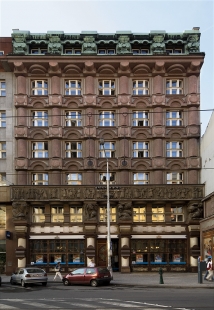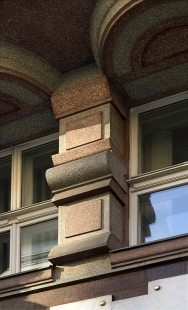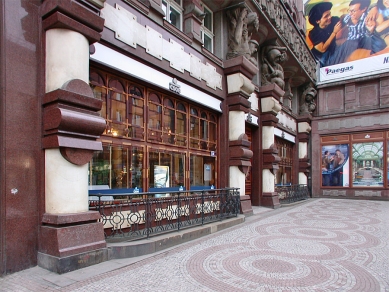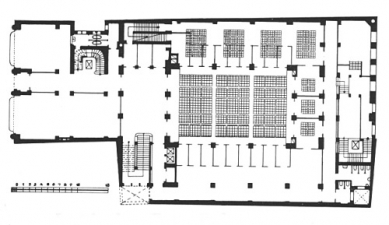
Legiobanka

Two adjacent buildings, which today house the Czechoslovak Commercial Bank, were originally constructed by the Bank of Czechoslovak Legions between 1921 and 1939. The first building of the Legiobank was built on the site of a single-storey late Classicist house from the mid-19th century, which was demolished. The house used to host the famous, probably the first Prague cabaret U Bucků and the brewery of the same name. In 1919, there arose a need for a bank for Czechoslovak legionnaires in Russia and France, so they could deposit their surplus wages and money from the sale of unconsumed food rations. The bank's offices were initially in the Štefánik Barracks and later in the hotel U Saského dvora, located at the corner of Hybernská and Senovážná, from where they moved to the newly built building. The building was designed by Josef Gočár in the then-new architectural style of rondocubism. It is also referred to as national style or arched cubism. The idea was that the original cubist edges, cubes, and pyramids were softened and rounded into arcs in the spirit of Slavic tradition. The relatively narrow facade of the building stands out with remarkable mass and strongly profiled arched cornices. The building is set deeper into the ground, leaving a wider sidewalk in front; it is five stories tall with an attic. A right longitudinal and rear transverse wing is attached to its front section. The courtyard space is filled with a ground-floor building housing a three-nave hall of the bank's atrium. The construction was carried out by the firm F. Troníček and the concrete company Nekvasil. Gočár enlisted the help of his friends and eminent artists: Jan Štursa, the author of four sculptures of legionnaires placed atop the pillars of the main entrance, and Otto Gutfreund, who created a sandstone relief with the theme of battles and the return of the legions on the parapet of the second floor. František Kysela is the author of the stained glass at the head of the three-part vault of the generous skylight above the bank hall and the author of the interior painting decoration. The original painting decoration has been best preserved in the columned hall of the waiting room on the first floor in the so-called columbarium. The bank's furnishings were produced according to designs by Josef Gočár. In the basement of the building, a concert hall with an organ was built, which was converted into a theater hall. The D 34 E F. Burian theater performed here.
Legiobanka was doing very well, so in 1937-38 it had a second building added in the neighborhood - a modern house in the functionalist style designed by architect František Marek, a pupil of Gočár at the AVU. This building is interconnected with Gočár's building. Its atrium, especially with a glass-concrete vault without visible ribs, is valuable, as are the architectural details of the railings, door fittings, etc. This building is sometimes referred to as the Golden Ear, which probably relates to the decoration on the second floor, featuring a motif of a wrought ear according to the design by Josef Kaplický. Part of the new building became a passage with the famous automat U Rozvařilů, whose name refers to the cabaret pub, popular before the First World War. The second functionalist building was built by the firm Lanna a.s. and Dr. Skorkovský. After February 1948, Legiobanka was incorporated into the State Bank of Czechoslovakia, and both buildings served administrative purposes for years. Only in 1990 did the Czechoslovak Commercial Bank purchase the complex of both buildings and began its grand reconstruction and completion. The author of the reconstruction concept is architect Ing. V. Obadálek, and the project documentation was drawn up under the leadership of Ing. Jan Janoušek, with construction by the firm Konstruktiva. Construction work took place from 1992 to 1994. Inappropriate courtyard extensions were demolished, and in their place, a six-story administrative building with an underground parking lot was built according to Jan Janoušek's project, with interiors designed and supplemented with contemporary elements by Marek Houska. A new thoroughfare was created here, which included a fountain and an artificial park landscape. At the same time, the theater hall was reconstructed according to the projects of architects Miroslav Melena and Ivan Plicka. A versatile space was created within it with two halls capable of accommodating any scene from a classic proscenium to an arena. The capacity, depending on its use, ranges from 250 to 1200 spectators. The theater is now called Archa, as the main hall somewhat resembles the deck of a ship. The buffet with the restaurant U Rozvařilů was also renovated. The overall reconstruction of the complex included the restoration of the original ornaments in the interiors, the fittings of railings and grilles, doors, flooring, and furniture. The sensitive reconstruction and accurate replicas of the original furnishings have made this bank branch a unique gem among modern monuments.
Legiobanka was doing very well, so in 1937-38 it had a second building added in the neighborhood - a modern house in the functionalist style designed by architect František Marek, a pupil of Gočár at the AVU. This building is interconnected with Gočár's building. Its atrium, especially with a glass-concrete vault without visible ribs, is valuable, as are the architectural details of the railings, door fittings, etc. This building is sometimes referred to as the Golden Ear, which probably relates to the decoration on the second floor, featuring a motif of a wrought ear according to the design by Josef Kaplický. Part of the new building became a passage with the famous automat U Rozvařilů, whose name refers to the cabaret pub, popular before the First World War. The second functionalist building was built by the firm Lanna a.s. and Dr. Skorkovský. After February 1948, Legiobanka was incorporated into the State Bank of Czechoslovakia, and both buildings served administrative purposes for years. Only in 1990 did the Czechoslovak Commercial Bank purchase the complex of both buildings and began its grand reconstruction and completion. The author of the reconstruction concept is architect Ing. V. Obadálek, and the project documentation was drawn up under the leadership of Ing. Jan Janoušek, with construction by the firm Konstruktiva. Construction work took place from 1992 to 1994. Inappropriate courtyard extensions were demolished, and in their place, a six-story administrative building with an underground parking lot was built according to Jan Janoušek's project, with interiors designed and supplemented with contemporary elements by Marek Houska. A new thoroughfare was created here, which included a fountain and an artificial park landscape. At the same time, the theater hall was reconstructed according to the projects of architects Miroslav Melena and Ivan Plicka. A versatile space was created within it with two halls capable of accommodating any scene from a classic proscenium to an arena. The capacity, depending on its use, ranges from 250 to 1200 spectators. The theater is now called Archa, as the main hall somewhat resembles the deck of a ship. The buffet with the restaurant U Rozvařilů was also renovated. The overall reconstruction of the complex included the restoration of the original ornaments in the interiors, the fittings of railings and grilles, doors, flooring, and furniture. The sensitive reconstruction and accurate replicas of the original furnishings have made this bank branch a unique gem among modern monuments.
The English translation is powered by AI tool. Switch to Czech to view the original text source.
0 comments
add comment


















